The Large Cap Value style ranks fourth out of the twelve fund styles as detailed in my style rankings for ETFs and mutual funds. It gets my Neutral rating, which is based on aggregation of ratings of 39 ETFs and 727 mutual funds in the Large Cap Value style as of October 17, 2012. Prior reports on the best & worst ETFs and mutual funds in every sector and style are here.
Figures 1 and 2 show the five best and worst-rated ETFs and mutual funds in the style. Not all Large Cap Value style ETFs and mutual funds are created the same. The number of holdings varies widely (from 15 to 1,354), which creates drastically different investment implications and ratings. The best ETFs and mutual funds allocate more value to Attractive-or-better-rated stocks than the worst, which allocate too much value to Neutral-or-worse-rated stocks.
To identify the best and avoid the worst ETFs and mutual funds within the Large Cap Value style, investors need a predictive rating based on (1) stocks ratings of the holdings and (2) the all-in expenses of each ETF and mutual fund. Investors need not rely on backward-looking ratings. My fund rating methodology is detailed here.
Investors seeking exposure to the Large Cap Value style should buy one of the Attractive-or-better rated ETFs or mutual funds from Figures 1 and 2.
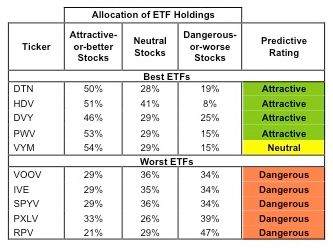
* Best ETFs exclude ETFs with less NAV’s less than 100 million.
Sources: New Constructs, LLC and company filings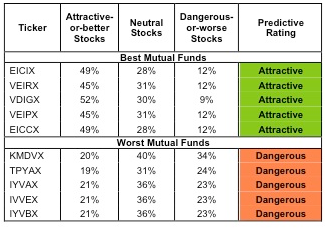
* Best mutual funds exclude funds with NAV’s less than 100 million.
Sources: New Constructs, LLC and company filings
Four mutual funds are excluded from Figure 2 because their total net assets (TNA) are below $100 million and do not meet our liquidity standards.
WisdomTree Dividend ex-Financials Fund (DTN) is my top-rated Large Cap Value ETF and FundVantage Trust: EIC Value Fund (EICIX) is my top-rated Large Cap Value mutual fund. Both earn my Attractive rating.
Rydex S&P 500 Pure Value ETF (RPV) is my worst-rated Large Cap Value ETF and Ivy Funds: Ivy Value Fund (IYVBX) is my worst-rated Large Cap Value mutual fund. Both earn my Dangerous rating.
Figure 3 shows that 448 out of the 1,698 stocks (over 44% of the total net assets) held by Large Cap Value ETFs and mutual funds get an Attractive-or-better rating. However, only 4 out of 39 Large Cap Value ETFs (less than 18% of total net assets) and 12 out of 727 Large Cap Value mutual funds (less than 5% of total net assets) get an Attractive-or-better rating.
The takeaway is: you cannot simply take an ETF or a mutual fund by a style label or its top five holdings. ETFs and mutual funds with the same style label can have drastically different holdings that will translate into significantly different returns for your investment portfolio.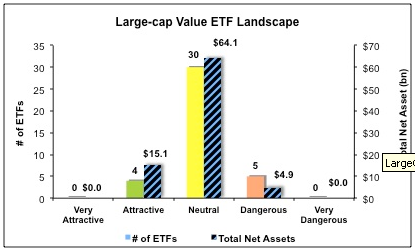
Sources: New Constructs, LLC and company filings
As detailed in Cheap Funds Dupe Investors, the fund industry offers many cheap funds but very few funds with high-quality stocks, or with what I call good portfolio management.
Investors need to tread carefully when considering Large Cap Value ETFs and mutual funds, as only four ETFs and 12 mutual funds in the Large Cap Value style allocate enough value to Attractive-or-better-rated stocks to earn an Attractive rating. To demonstrate the difference between good and bad portfolio management, I have selected a Very Attractive stock from an Attractive mutual fund (EICIX) and a Very Dangerous Stock from a Dangerous mutual fund (TPYAX).
Baxter International Inc. (BAX) is one of my favorite stocks held by Large Cap Value ETFs and mutual funds and earns my Very Attractive rating. Baxter achieved a return on invested capital (ROIC) of 16.5% in 2011; this is in 87th percentile of all Russell 3000 companies. During all 14 years in my model, BAX has generated positive economic earnings. Baxter is not only a great company; it is also an attractive stock due to the market’s pessimistic view of future cash flows. The company’s current stock price (~$61.60) implies that after-tax profits (NOPAT) will permanently decrease by 27%. This seems unlikely given that the company has increased its profits by an average of 12% over the thirteen years in my model. Low expectations and strong historical performance make Baxter an excellent long candidate.
Digital Realty Trust, Inc. (DLR) is one of my least favorite stocks held by Large Cap Blend ETFs and mutual funds and earns my Very Dangerous rating. DLR has misleading earnings -- its economic earnings are negative and declining while its reports accounting earnings are positive and increasing. During the eight years in my model, the company has never generated positive economic earnings. Not only is DLR not profitable, it is also overvalued. To justify its current stock price (~$66.95), the company must increase profits by 16% compounded annually for 15 years. That is a lot of future value creation for a company that has never created value. Investors should avoid this stock.
Figures 4 and 5 show the rating landscape of all Large Cap Value ETFs and mutual funds.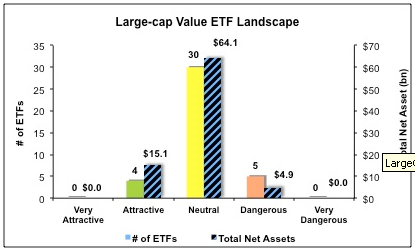
Sources: New Constructs, LLC and company filings 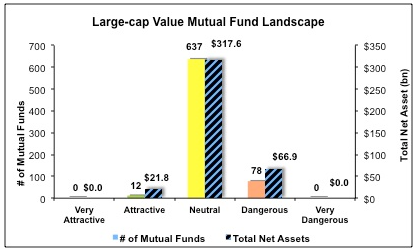
Sources: New Constructs, LLC and company filings
Review my full list of ratings and rankings along with reports on all 38 ETFs and 734 mutual funds in the Large Cap Value style.
Disclosure: I own BAX I receive no compensation to write about any specific stock, sector, style or theme.
- English (UK)
- English (India)
- English (Canada)
- English (Australia)
- English (South Africa)
- English (Philippines)
- English (Nigeria)
- Deutsch
- Español (España)
- Español (México)
- Français
- Italiano
- Nederlands
- Português (Portugal)
- Polski
- Português (Brasil)
- Русский
- Türkçe
- العربية
- Ελληνικά
- Svenska
- Suomi
- עברית
- 日本語
- 한국어
- 简体中文
- 繁體中文
- Bahasa Indonesia
- Bahasa Melayu
- ไทย
- Tiếng Việt
- हिंदी
Best/Worst ETFs And Mutual Funds: Large Cap Value Style
Published 10/19/2012, 11:55 AM
Updated 07/09/2023, 06:31 AM
Best/Worst ETFs And Mutual Funds: Large Cap Value Style
Latest comments
Loading next article…
Install Our App
Risk Disclosure: Trading in financial instruments and/or cryptocurrencies involves high risks including the risk of losing some, or all, of your investment amount, and may not be suitable for all investors. Prices of cryptocurrencies are extremely volatile and may be affected by external factors such as financial, regulatory or political events. Trading on margin increases the financial risks.
Before deciding to trade in financial instrument or cryptocurrencies you should be fully informed of the risks and costs associated with trading the financial markets, carefully consider your investment objectives, level of experience, and risk appetite, and seek professional advice where needed.
Fusion Media would like to remind you that the data contained in this website is not necessarily real-time nor accurate. The data and prices on the website are not necessarily provided by any market or exchange, but may be provided by market makers, and so prices may not be accurate and may differ from the actual price at any given market, meaning prices are indicative and not appropriate for trading purposes. Fusion Media and any provider of the data contained in this website will not accept liability for any loss or damage as a result of your trading, or your reliance on the information contained within this website.
It is prohibited to use, store, reproduce, display, modify, transmit or distribute the data contained in this website without the explicit prior written permission of Fusion Media and/or the data provider. All intellectual property rights are reserved by the providers and/or the exchange providing the data contained in this website.
Fusion Media may be compensated by the advertisers that appear on the website, based on your interaction with the advertisements or advertisers.
Before deciding to trade in financial instrument or cryptocurrencies you should be fully informed of the risks and costs associated with trading the financial markets, carefully consider your investment objectives, level of experience, and risk appetite, and seek professional advice where needed.
Fusion Media would like to remind you that the data contained in this website is not necessarily real-time nor accurate. The data and prices on the website are not necessarily provided by any market or exchange, but may be provided by market makers, and so prices may not be accurate and may differ from the actual price at any given market, meaning prices are indicative and not appropriate for trading purposes. Fusion Media and any provider of the data contained in this website will not accept liability for any loss or damage as a result of your trading, or your reliance on the information contained within this website.
It is prohibited to use, store, reproduce, display, modify, transmit or distribute the data contained in this website without the explicit prior written permission of Fusion Media and/or the data provider. All intellectual property rights are reserved by the providers and/or the exchange providing the data contained in this website.
Fusion Media may be compensated by the advertisers that appear on the website, based on your interaction with the advertisements or advertisers.
© 2007-2025 - Fusion Media Limited. All Rights Reserved.
